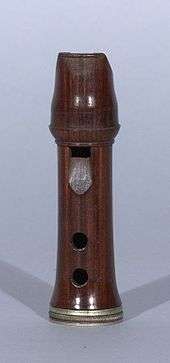Picco pipe
 | |
| Classification | |
|---|---|
| Playing range | |
| 1-2 octaves | |
| Related instruments | |
The picco pipe is the smallest form of ducted-flue tabor pipe or flute-a-bec.
It is 3½" long, with the windway taking up 1½". It has only three holes: two in front and a dorsal thumb hole. It has the same mouthpiece as a recorder. The bore end hole of the picco pipe has a small flare, and the lowest notes were played with a finger blocking this end.
The range is from b to c3, using the slight frequency shift between registers to sound a full chromatic scale, like the tabor pipe.[1]
It was popularized in 1856 at Covent Garden in London by a 25-year-old blind Sardinian player.[2]
See also
References
- ↑ Library of Congress: Dayton C. Miller Flute Collection
- ↑ George Grove, "Picco", A Dictionary of Music and Musicians (A.D. 1450–1880), by Eminent Writers, English and Foreign, vol. 2, edited by George Grove, D. C. L., 340–43. London: Macmillan and Co.: 750
External links
This article is issued from Wikipedia - version of the Thursday, March 06, 2014. The text is available under the Creative Commons Attribution/Share Alike but additional terms may apply for the media files.